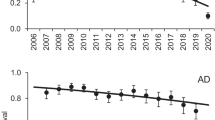Abstract
The response of an Australian arid-zone gecko community to sulphur dioxide and salt spray from a mine and industrial site was investigated from 1992 to 1995. Geckos were abundant and fecund at control sites in chenopod shrubland and annual capture rates were strongly influenced by minimum night temperatures. Capture rate and percentage of females gravid at sites exposed to high concentrations of air pollutants were significantly lower than at control sites. Discrepancies between control and impacted sites were greatest for the termite-specialist geckos Diplodactylus conspicillatus and Rhynchoedura ornata. An increase in capture rates and percentage of females gravid at sites close to the industrial site, followed a reduction in peak sulphur dioxide emissions. Geckos may be sensitive and useful bioindicators of the environmental impacts of some atmospheric pollutants.
Similar content being viewed by others

Author information
Authors and Affiliations
Additional information
Received: 1 September 1997 / Accepted: 17 November 1997
Rights and permissions
About this article
Cite this article
Read, J. Are geckos useful bioindicators of air pollution?. Oecologia 114, 180–187 (1998). https://doi.org/10.1007/s004420050434
Issue Date:
DOI: https://doi.org/10.1007/s004420050434



